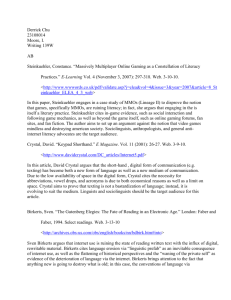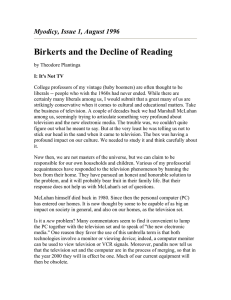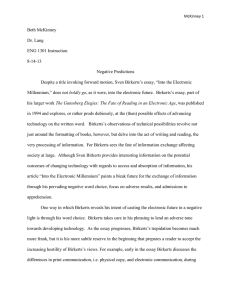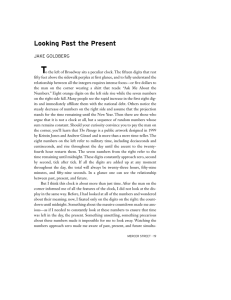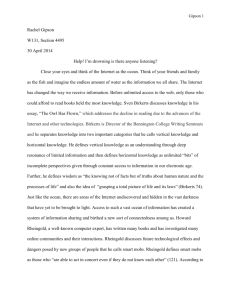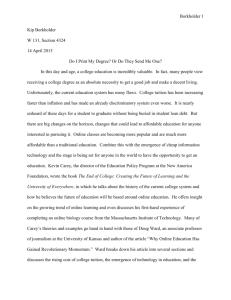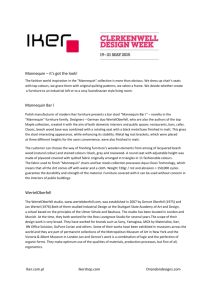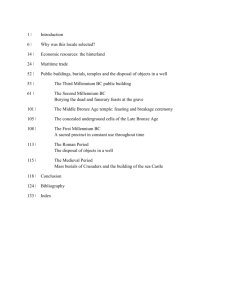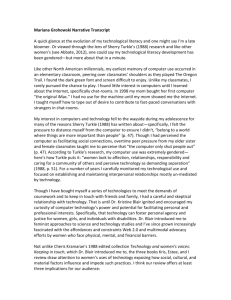THE HUMAN MANNEQUIN
advertisement
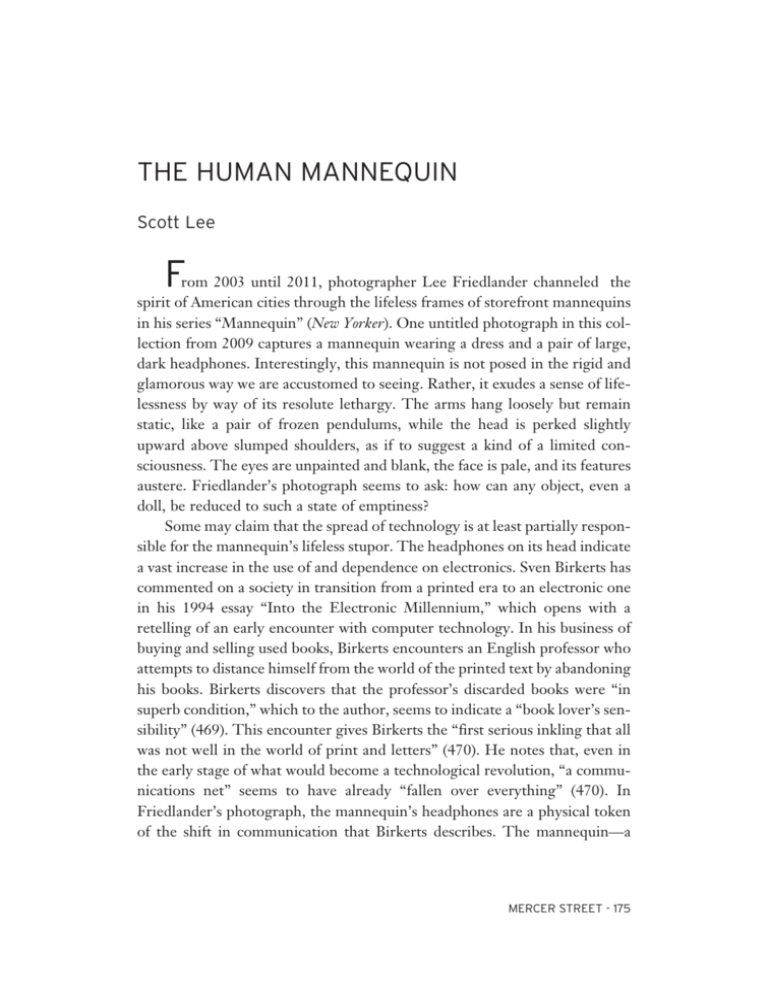
THE HUMAN MANNEQUIN Scott Lee F rom 2003 until 2011, photographer Lee Friedlander channeled the spirit of American cities through the lifeless frames of storefront mannequins in his series “Mannequin” (New Yorker). One untitled photograph in this collection from 2009 captures a mannequin wearing a dress and a pair of large, dark headphones. Interestingly, this mannequin is not posed in the rigid and glamorous way we are accustomed to seeing. Rather, it exudes a sense of lifelessness by way of its resolute lethargy. The arms hang loosely but remain static, like a pair of frozen pendulums, while the head is perked slightly upward above slumped shoulders, as if to suggest a kind of a limited consciousness. The eyes are unpainted and blank, the face is pale, and its features austere. Friedlander’s photograph seems to ask: how can any object, even a doll, be reduced to such a state of emptiness? Some may claim that the spread of technology is at least partially responsible for the mannequin’s lifeless stupor. The headphones on its head indicate a vast increase in the use of and dependence on electronics. Sven Birkerts has commented on a society in transition from a printed era to an electronic one in his 1994 essay “Into the Electronic Millennium,” which opens with a retelling of an early encounter with computer technology. In his business of buying and selling used books, Birkerts encounters an English professor who attempts to distance himself from the world of the printed text by abandoning his books. Birkerts discovers that the professor’s discarded books were “in superb condition,” which to the author, seems to indicate a “book lover’s sensibility” (469). This encounter gives Birkerts the “first serious inkling that all was not well in the world of print and letters” (470). He notes that, even in the early stage of what would become a technological revolution, “a communications net” seems to have already “fallen over everything” (470). In Friedlander’s photograph, the mannequin’s headphones are a physical token of the shift in communication that Birkerts describes. The mannequin—a MERCER STREET - 175 symbol of fashion—sports these headphones as an essential part of the new norm. In the second half of his essay, Birkerts expresses his concerns about the potential effects the transition into the electronic millennium may have on society. He presents three possible developments as we move into his titular electronic millennium: “language erosion,” a “flattening of historical perspectives,” and “the waning of the private self” (474, 475). Birkerts claims that “language erosion” is already occurring, and as a result, the “complex discourse patterns of the nineteenth century [are being] flattened by the requirements of communication over distances” (474). Birkerts claims that this erosion is “dumbing down discourse,” resulting in a standardization of both language and expression (474). His second concern is that “changes in information storage and access” will “impinge on our historical memory” (475). In the electronic millennium, Birkerts argues, it has become increasingly easier to quickly find historical information while, in the era of printed text, historical fact was “the contemplation of the single volume, or mass of volumes” (475). Birkerts claims that this easy access to information isolates history into disconnected, out-of-context facts, flattening and standardizing history and the perspective from which it is recorded (475). The standardization of history leads to his third prediction: “social collectivization that will over time all but vanquish the ideal of the isolated individual” (475). Birkerts worries that there is a shrinking “physical and psychological distance between individuals,” and that, at some point, standardized web content will eliminate “differentiations of subjective individualism” (475). Readers of Birkerts might see assimilation as the message behind Friedlander’s mannequin. It becomes a humanoid doll representing the loss of the individual mind as it becomes entangled in the invisible, intangible web of the electronic millennium. The future Birkerts foresees is indeed bleak and also a potential explanation for why Friedlander sought to capture the mindless stupor of the storefront mannequin. Perhaps it is too early to observe and measure the possible fallout of this shift from active engagement to apathy. While wary of its effects, Birkerts points out that this transition into the electronic millennium is not an abrupt one. He equates what he calls the “‘proto-electronic’” period of the 1990s to the Ancient Greek period that historian Eric Havelock calls “‘protoliteracy’”: the slow transition from oral to literate culture (471). 176 - MERCER STREET However, unlike ancient Greece, “our historical moment . . . will not require a transition period of two centuries,” but only about fifty years (471). Birkerts believes that the nature of the digital revolution will enable technology to “surmount impedances and to hasten transitions” (471). It has been twenty years since Birkerts’s essay was published, and while it may still be too early to panic about humanity’s damnation to a state of soullessness, debates and research on the impact of technology have begun to surface. The Pew Internet & American Life report, The Strength of Internet Ties, written by Director Lee Rainie and a team of colleagues, challenges fears that have arisen with the advent of new technologies, specifically the concern “that social relationships—and community—are fading away in America” (i). Rainie and his colleagues find that community ties are not disappearing, but instead are transforming alongside the electronic millennium. He claims that “the internet fits seamlessly with in-person and phone encounters,” discrediting concerns that email would replace these more intimate forms of communication (i). By surveying the frequency and methods of communication among people with “very close relationships,” Rainie finds “no evidence that email replaces other forms of contact” (5, 22). In fact, he presents evidence that communication over the internet actually increases in-person and phone encounters and facilitates regular contact between distant relatives, colleagues, and friends. Rainie concludes that “people who communicate frequently use multiple media to do so,” a phenomenon he calls “media multiplexity” (23). Rainie and his colleagues seem to praise “media multiplexity,” yet these new electronic forms of communication also speak to Birkerts’s three predictions. While Rainie argues that forms of communication have remained intact, Birkerts’s concern with the erosion of language can be seen in textbased internet communication—a format which demands concision and efficiency. This is most evident in email and instant messaging, in which abbreviations and shorthand terms have become commonplace. A new sublanguage has emerged, comprised of terms such as “lol,” “brb,” “btw,” “ikr,” and “omw,” which internet users are expected to know instinctively. This new sublanguage, and the rapid, constant communication that it promotes, draws the individual into the webbed collective formed by the many users of electronic media, which Birkerts sees as an imminent destruction of the private MERCER STREET - 177 self and private life. Rainie, however, sees technology as an efficient means of sharing and nurturing the individual self, promoting “networked individualism”: users actively seeking out “appropriate people and resources for different situations” (2). Friedlander’s photograph seems to reflect Birkerts’s more negative outlook of the electronic age, yet Rainie would challenge the notion that instant and continuous communication is necessarily a destructive force. In fact, Rainie’s perspective casts new light on the effects of technology, which may not foster the the mindless and lifeless society that Friedlander’s image suggests. Sherry Turkle’s 2006 essay, “Tethering,” focuses on technology’s effects on the individual, providing another voice in Birkerts’s and Rainie’s debate. Discussing the early age of social media, she describes a group of MIT researchers who “seemed at a remove from their bodies” due to their multiple electronic accessories (235). Because the researchers were deeply immersed in wearable technology, Turkle refers to them as cyborgs, implying that, at one point, humans and technology became inseparable—a link she calls “tethering” (236). She contrasts the private “intimacies [that] were shared in face-to-face conversations” with a person talking loudly on a cell phone in public, “behaving as though no one around is listening” (236). She explains that with the advent of communications technology, “each [person] inhabits a private media bubble,” which means physical proximity to others has become irrelevant; by allowing a constant connection to social networks, technology has diminished the need for an active engagement with the physical present (236). Perhaps Turkle’s account of the MIT researchers reveals a frightening truth: when confronted with a digital network, our minds become more seduced by a virtual, rather than physical reality. While technology does not force us to assimilate to the reality it presents, it seems somehow to convince us that the physical world can be adequately represented by a digital network. In the second half of “Tethering,” Turkle observes the possible effects that a tethered relationship between the self and technology may have on the roles we play in everyday life. For example, Turkle explains that “in the past [she] did not have to perform [her] role as a mother in the presence of [her] professional colleagues” (237). Now, with the aid of technology, she can balance her roles as a mother and a professional “so quickly that they become 178 - MERCER STREET almost simultaneous” (237). This new ability to fulfill multiple roles simultaneously may at first seem to improve our lives, but Turkle points out that the blurred lines between roles can result in the “erosion of the boundary between work and personal life” (237). Turkle’s evidence reveals that technology—under the guise of ease and convenenience—prevents us from effectively orienting ourselves in our physical environments. However, her findings should be considered against other research, which claims that technology can enrich our lives, both on and off the web. In January 2014, Isabela Granic and others published their article, “The Benefits of Playing Video Games,” in American Psychologist. Granic and her colleagues attempt to “summarize the research on the positive effects of playing video games, focusing on four main domains: cognitive, motivational, emotional, and social” (66). Their research contrasts “the vast majority of psychological research” on this topic, which has focused on “aggression, addiction, and depression” (66). Their most notable finding is the positive effect that video games, particularly those involving multiple players, can have in the social domain. The researchers find that in the current age of online gaming, “decisions need to be made on the fly about whom to trust, whom to reject, and how to most effectively lead a group” (73). Because of this active social environment, the researchers “propose that gamers are rapidly learning social skills and prosocial behavior that might generalize to their peer and family relations outside the gaming environment” (73). While Turkle claims that communications technology can inhibit essential life skills, Granic and her colleagues have found that the same technology can foster emotional intelligence and adaptive learning. While online gaming can encourage this productive, social environment, the researchers concede that these positive social effects are only evident in cooperative games, not in competitive game play. Granic and her colleagues note that “the critical dimension that seems to determine whether violent games associated with helping, prosocial behavior versus malevolent, antisocial behavior is the extent to which they are played cooperatively versus competitively” (73). In other words, the social and independent development that can come from immersing oneself in an online community only occurs under the particular conditions that everyone is cooperating with one another. MERCER STREET - 179 With the conflicting opinions and research available, it is difficult to evaluate the effects of communications technology as a whole. Friedlander’s photograph seems to represent the concerns regarding the state of the individual, questioning whether a new, virtual reality diminishes the living being to a slumped and lethargic shell of its former self. Turkle and Birkerts argue that technology has negatively affected the individual self and our interactions with the world. Yet, there is evidence to imply that the same technology facilitates social growth that would perhaps not be possible without these innovations. To conclude that communications technology is neither good nor bad is fallacious; neither claim cancels out the other. Rather, the reality is that communications technology is both good and bad. A more necessarily complex conclusion may be that the positive effects of communications technology compensate for the bad. In exchange for the ease and speed at which we can now communicate, as well as the development of essential social skills, we sacrifice our ability to develop independently, attaching ourselves to an ever-growing network. There is no way to conclusively prove that we, as human mannequins, are collectively better or worse off than we were before. The only appropriate course of action may be to rethink the use of technology and its potential benefits for the individual while continuously being aware of the concerns that Birkerts, Turkle, and Friedlander bring to the fore. We are left with no alternative; perhaps what we can most assuredly say is that the digital millennium is far from over. WORKS CITED Birkerts, Sven. “Into the Electronic Millennium.” Occasions for Writing. Ed. Robert DiYanni and Pat C. Hoy II. Boston: Wadsworth, 2008. 469-76. Print. Friedlander, Lee. “Untitled” (2009). Photograph. Mannequin. San Francisco: Fraenkel Gallery, 2012. Print. Granic, Isabela, Adam Lobel, and Rutger C.M.E Engels. “The Benefits of Playing Video Games.” American Psychologist 69.1 (2014): 66-78. Web. 2 Apr. 2014. 180 - MERCER STREET Rainie, Lee, Jeffrey Boase, John Horrigan, and Barry Wellman. Pew Internet & American Life Project. The Strength of Internet Ties. Washington D.C.: Pew Research Project, 25 Jan. 2006. PDF File. Turkle, Sherry. “Tethering.” Advanced College Essay for NYU POLY. Ed. Elisa Linksy and Pat C. Hoy II. Boston: Pearson, 2013. 235-41. Print. Wender, Jessie. “Lee Friedlander’s New York City Mannequins.” New Yorker (2012). Web. 18 June 2014. MERCER STREET - 181
